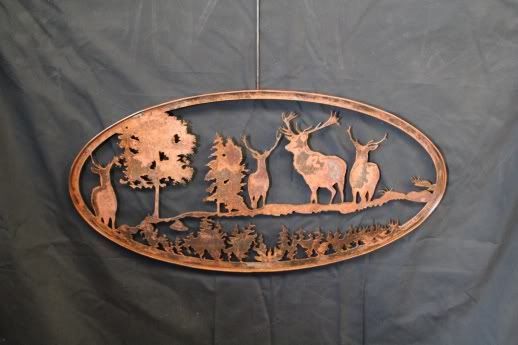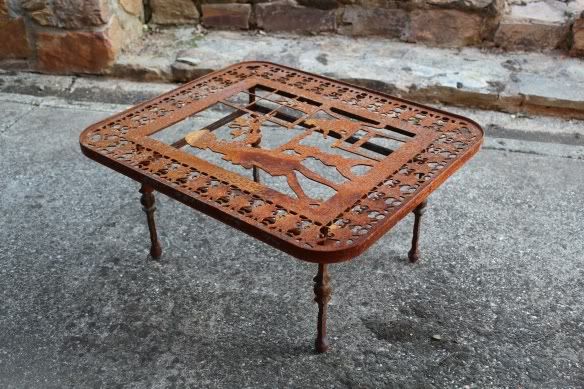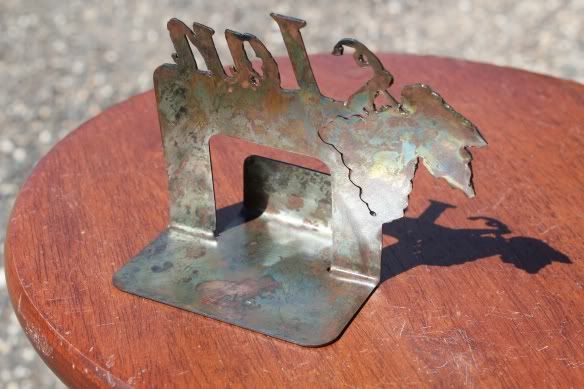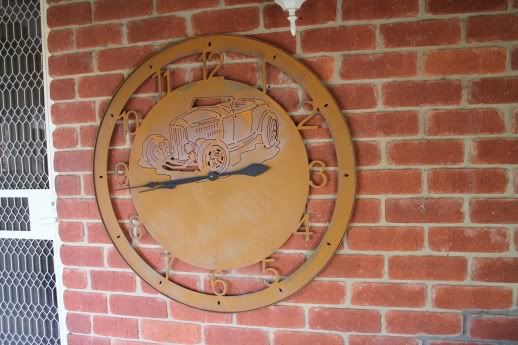What, if any, experience has anyone had with finding and using naturally occurring reactive agents with mild steel? I would like to use things that are found locally and have been experimenting with some. the range of colors is not too broad, but I have had some luck. I have tried different temperatures, wet vs. dry, length of exposure, etc.. I would eventually like to put together a pamphlet (free of course) for people wanting this sort of information.
Any advice is greatly appreciated. I wish I would have paid closer attention in chemistry when I had the chance.
Mike
Naturally occuring patina agents
- wapitismith
- 1 Star Member

- Posts: 22
- Joined: Wed Jun 15, 2011 9:09 am
- Location: Western Colorado
- Contact:
Naturally occuring patina agents
WapitiSmith
"There are strange things done in the midnight sun..."
"There are strange things done in the midnight sun..."
-
muzza
- 4 Star Member

- Posts: 1447
- Joined: Wed Feb 04, 2009 5:35 pm
Re: Naturally occuring patina agents
Not sure about natural but here in Oz the freight cost of getting Bills finishes in makes it pretty much prohibitive so a while back I had a play around using copper sulphate crystals (bluestone) diluted in water.
First 2 pics are a couple of pieces cut from hot rolled which I washed with diluted Hydrochloric acid to remove the mill scale in areas but not all and then sprayed and rinsed with the copper sulphate solution, then dried and painted with pressure pack clear. I did a few pieces and no 2 parts came out the same with the end result varying quite a bit in darkness and coloring.


This one I did the same to try and replicate but it kept turning out pink so I went back over it and scrubbed it with acid, now it's rusty

This next pic is a business card holder cut from cold rolled which I sanded and polished with a worn out flap disc and then used the same diluted copper sulphate, as you can see by the second photo the reverse side actually came out better
but the end result was quite a mix of browns, blues and green, again cleared with the trusty pressure pack.


This clock was also cut from hot rolled and sand blasted, I then layed it flat and sprayed it with diluted Hydochloric acid and rinsed off with water, I then let it dry naturally and a bit hard to see but where the water puddled on the roadster it created darker rusted bits. i left this one hanging on the verandah uncoated for about 3 years before someone just had to have that one and bought it, still looking pretty much unchanged even though it's a fairly damp environment.

like I said not really natural but a few bits I've done.
Murray
First 2 pics are a couple of pieces cut from hot rolled which I washed with diluted Hydrochloric acid to remove the mill scale in areas but not all and then sprayed and rinsed with the copper sulphate solution, then dried and painted with pressure pack clear. I did a few pieces and no 2 parts came out the same with the end result varying quite a bit in darkness and coloring.


This one I did the same to try and replicate but it kept turning out pink so I went back over it and scrubbed it with acid, now it's rusty

This next pic is a business card holder cut from cold rolled which I sanded and polished with a worn out flap disc and then used the same diluted copper sulphate, as you can see by the second photo the reverse side actually came out better
but the end result was quite a mix of browns, blues and green, again cleared with the trusty pressure pack.


This clock was also cut from hot rolled and sand blasted, I then layed it flat and sprayed it with diluted Hydochloric acid and rinsed off with water, I then let it dry naturally and a bit hard to see but where the water puddled on the roadster it created darker rusted bits. i left this one hanging on the verandah uncoated for about 3 years before someone just had to have that one and bought it, still looking pretty much unchanged even though it's a fairly damp environment.

like I said not really natural but a few bits I've done.
Murray
-
hkranch
- 1/2 Star Member

- Posts: 1
- Joined: Thu Mar 01, 2012 12:50 pm
Re: Naturally occuring patina agents
I am using Bill's patina finishes and dyes. I am using Harbor Freight hobbie brushes for the dyes but you have to cut the brisles off to about 1/2 inch and crimp the metal again so they don't fall out. If you leave them long, you can't get a consistent brush stroke. I tried Qtips but they seem to wipe the color off. I am going to try a sprayer next
hk ranch
hk ranch
-
rtsplace
- 2 Star Member

- Posts: 83
- Joined: Tue Nov 29, 2011 7:25 am
Re: Naturally occuring patina agents
Hello All, I too have played with copper crystals, found an old article in Popular Mechanics magazine 1930's - 1940's era they added 1 oz. battery acid, 2 oz. crystals, 1 gal. distilled water. Works very well. Have done lots of seraching in chemical site best search word is Patina formulas instead of reciepes, I guess it's a chemist thing/cooks use reciepes.
Good Luck............Ray
Good Luck............Ray
-
DARRYL21270
- 3 Star Member

- Posts: 478
- Joined: Fri Jun 05, 2009 7:09 am
- Location: New Jersey
- Contact:
Re: Naturally occuring patina agents
Check out this site also. They have all different chemicals and recipes for different effects also 
http://www.sciencecompany.com/-W12C672.aspx#4
For some reason the link wouldn't load so just go here http://www.sciencecompany.com and click the chemicals link on the top left of the page and then click Patinas. If you click on a formula # it will bring up a list of different recipes along with the effects of each along with instructions.
http://www.sciencecompany.com/-W12C672.aspx#4
For some reason the link wouldn't load so just go here http://www.sciencecompany.com and click the chemicals link on the top left of the page and then click Patinas. If you click on a formula # it will bring up a list of different recipes along with the effects of each along with instructions.
- steelfx
- 4 Star Elite Contributing Member

- Posts: 762
- Joined: Sat Oct 10, 2009 12:09 am
- Location: St. George, Utah
- Contact:
Re: Naturally occuring patina agents
Thank you for your support. I appreciate it.hkranch wrote:I am using Bill's patina finishes and dyes. I am using Harbor Freight hobbie brushes for the dyes but you have to cut the brisles off to about 1/2 inch and crimp the metal again so they don't fall out. If you leave them long, you can't get a consistent brush stroke. I tried Qtips but they seem to wipe the color off. I am going to try a sprayer next
hk ranch
Bill
- steelfx
- 4 Star Elite Contributing Member

- Posts: 762
- Joined: Sat Oct 10, 2009 12:09 am
- Location: St. George, Utah
- Contact:
Re: Naturally occuring patina agents
ScienceCompany.com is a great site...if you're working with Brass, Bronze or Copper. There's a lot of good information there and they'll be glad to sell you small amounts of chemicals to experiment with. However, they don't work on steel or iron & they don't guarantee the results.DARRYL21270 wrote:Check out this site also. They have all different chemicals and recipes for different effects also
http://www.sciencecompany.com/-W12C672.aspx#4
For some reason the link wouldn't load so just go here http://www.sciencecompany.com and click the chemicals link on the top left of the page and then click Patinas. If you click on a formula # it will bring up a list of different recipes along with the effects of each along with instructions.
thanks,
Bill
You currently do not have access to download this file.
To gain download access for DXF, SVG & other files Click Here
-
frodin1
- 1/2 Star Member

- Posts: 3
- Joined: Tue May 01, 2012 10:50 am
Re: Naturally occuring patina agents
Read something a long time ago about different fetilizers causing certain reactions on steel and other surfaces. I'm assuming it's because of the high acidic content in some of them, while others have their own high iron content, "If you've noticed the rust burns on cement ?" Let us know what you find, and send me a pamphlet once done. Thanks!

